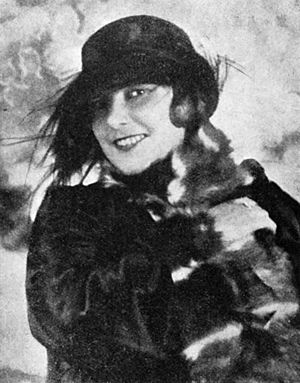Julie Reisserová facts for kids
Julie Reisserová (born October 9, 1888, died February 25, 1938) was a talented Czech composer. She also wrote about music for the public. She was born in Prague and became known for her beautiful musical works.
About Julie Reisserová
Julie Reisserová was born in Prague, a city in the Czech Republic. She loved music from a young age. She started by learning to play the piano. Her teacher was Adolf Mikeš. She also learned to sing with Richard Figar.
From 1919 to 1921, Julie studied how to compose music. She learned in Prague with a famous composer named Josef Bohuslav Foerster. She continued her studies in Bern, Switzerland, with Ernst Hohlfeld. Later, she learned from two very important composers: Albert Roussel (from 1924 to 1929) and Nadia Boulanger.
In 1921, Julie married Jan Reisser. He was a Czech diplomat. A diplomat is someone who represents their country in other nations. Because of his job, Julie moved with him to different countries. They lived in Switzerland (1921–1929), Belgrade (1930–1933), and Copenhagen (1933–1936). Even while traveling, Julie kept working on her music. Her compositions were performed in many cities. These included Bern, Paris, Geneva, Copenhagen, and even Philadelphia in the United States.
Julie Reisserová also helped bring music to more people. She translated an operetta into Czech. An operetta is like a short, light opera with singing and speaking. The operetta she translated was called Le testament de la tante Caroline. It was written by Albert Roussel, one of her teachers. This operetta was first performed in Olomouc in 1936. It was also shown in Prague in 1937.
Her Musical Works
Julie Reisserová wrote many different kinds of music. Here are some of her well-known pieces:
- Suite for Orchestra (Suita pro orchestr), finished between 1928 and 1931. This is a collection of musical pieces for a large group of instruments.
- Pastorale Maritime for Orchestra (Pastorale Maritimo pro orchestr), from 1933. This piece likely sounds like a peaceful scene by the sea.
- Early spring (Předjaří), from 1936.
She also wrote pieces for smaller groups of instruments or for piano:
- Esquisses, from 1935. This means "sketches" and might be short, quick musical ideas.
- Deux Allegros (meaning "Two Fast Pieces").
Julie also composed songs:
- March (Březen), from 1934. These were songs for an orchestra.
- Sous la neige (Pod sněhem, meaning "Beneath the Snow"), from 1936. This was a group of songs for a singer and piano.
- Festive Day (Slavnostní den), from 1936. This piece was written for a women's choir. It was dedicated to Františka Plamínková, a famous Czech women's rights activist.
In 1934, Julie Reisserová also published a book. It was called In Margin Vitae. This book contained her own poems. She wrote these poems in Czech, German, French, and English.


